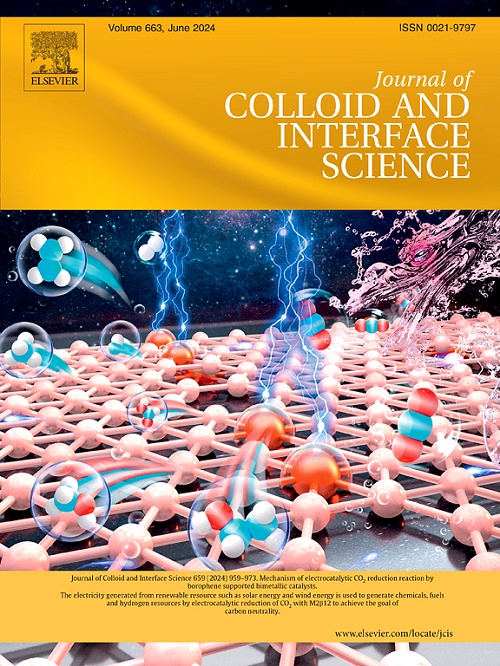ag掺杂中空多壳结构TiO2用于高选择性光催化CO2还原
IF 9.4
1区 化学
Q1 CHEMISTRY, PHYSICAL
引用次数: 0
摘要
光催化将CO2转化为有价值的CH4为紧迫的环境和能源挑战提供了可持续的解决方案。然而,这一过程受到几个因素的阻碍,包括CO2的低吸附和活化,光生载流子的快速重组以及有限的选择性。本文成功合成了具有高选择性光催化CO2甲烷化作用的Ag/TiO2 (Ag/TiO2)纳米球。时间分辨光致发光(TRPL)分析表明,Ag的掺杂使载流子寿命从1.32 ns延长到49.11 ns,有效抑制了复合。x射线光电子能谱(XPS)证实,Ag掺杂导致Ag和Ti位点的电子重新分布,从而优化了CO2在催化剂上的吸附。密度泛函理论(DFT)计算表明,Ag掺杂增强了对CO2的吸附(吸附能从- 1.54 eV增加到- 2.04 eV),影响了中间体的脱附,从而改变了反应产物,有利于生成CH4而不是CO。此外,Ag/TiO2中空的多壳结构使其具有较大的比表面积(142.4 m2/g),有利于CO2的吸附和活化。结果表明,Ag/TiO2的CH4产率达到89.51 μmol·g−1·h−1,是原始TiO2的6倍左右。对CH4的选择性提高到95%。这些发现突出了ag掺杂TiO2在有效光还原CO2方面的潜力。本文章由计算机程序翻译,如有差异,请以英文原文为准。

Ag-Doped hollow Multi-Shelled structure TiO2 for highly selective photocatalytic CO2 reduction
The photocatalytic conversion of CO2 into valuable CH4 offers a sustainable solution to pressing environmental and energy challenges. However, this process is hindered by several factors, including the low adsorption and activation of CO2, rapid recombination of photogenerated charge carriers, and limited selectivity. Herein, hollow multi-shelled Ag-doped TiO2 (Ag/TiO2) nanospheres were successfully synthesized for highly selective photocatalytic CO2 methanation. Time-resolved photoluminescence (TRPL) analysis reveals that Ag doping extends the carrier lifetime from 1.32 ns to 49.11 ns, effectively suppressing recombination. X-ray photoelectron spectroscopy (XPS) confirms that Ag doping leads to a redistribution of electron at Ag and Ti sites, thereby optimizing the adsorption of CO2 on the catalyst. Density functional theory (DFT) calculations indicate that Ag doping strengthens CO2 adsorption (the adsorption energy from −1.54 to −2.04 eV) and affects the desorption of intermediates, thereby altering the reaction products to favor the production of CH4 instead of CO. Moreover, the hollow multi-shelled structure endows Ag/TiO2 with a large specific surface area (142.4 m2/g), which is conducive to the adsorption and activation of CO2. Consequently, the CH4 yield of Ag/TiO2 reached 89.51 μmol·g−1·h−1, which is approximately 6 times greater than that of pristine TiO2. Additionally, the selectivity for CH4 improved to 95 %. These findings highlight the potential of Ag-doped TiO2 for efficient CO2 photoreduction.
求助全文
通过发布文献求助,成功后即可免费获取论文全文。
去求助
来源期刊
CiteScore
16.10
自引率
7.10%
发文量
2568
审稿时长
2 months
期刊介绍:
The Journal of Colloid and Interface Science publishes original research findings on the fundamental principles of colloid and interface science, as well as innovative applications in various fields. The criteria for publication include impact, quality, novelty, and originality.
Emphasis:
The journal emphasizes fundamental scientific innovation within the following categories:
A.Colloidal Materials and Nanomaterials
B.Soft Colloidal and Self-Assembly Systems
C.Adsorption, Catalysis, and Electrochemistry
D.Interfacial Processes, Capillarity, and Wetting
E.Biomaterials and Nanomedicine
F.Energy Conversion and Storage, and Environmental Technologies

 求助内容:
求助内容: 应助结果提醒方式:
应助结果提醒方式:


